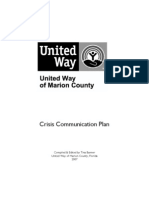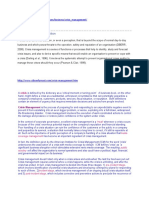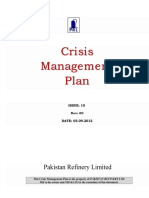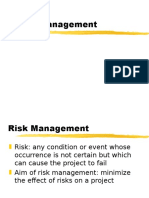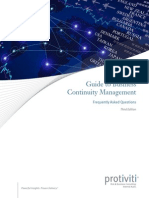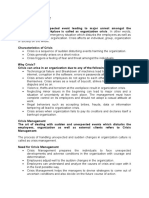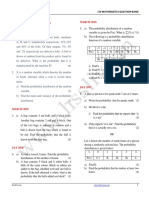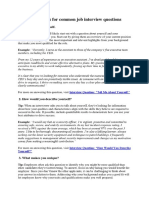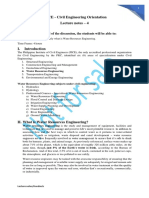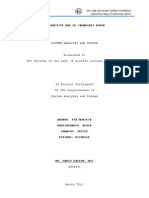100%(1)100% found this document useful (1 vote)
182 viewsCrisis Management
Crisis Management
Uploaded by
Suhail KhairyThe document discusses crisis, crisis management, and crisis communication. It defines a crisis as an unexpected, dangerous situation that creates instability and anxiety. Crisis management involves planning strategies to promptly respond to and minimize damage from a crisis. The objectives of crisis management are to identify the root cause, manage information flow, understand adversaries, and develop solutions. Effective crisis communication includes pre-crisis preparation, crisis response, post-crisis recovery, and establishing strong leadership, decision making, communication, and defined roles.
Copyright:
© All Rights Reserved
Available Formats
Download as PPTX, PDF, TXT or read online from Scribd
Crisis Management
Crisis Management
Uploaded by
Suhail Khairy100%(1)100% found this document useful (1 vote)
182 views14 pagesThe document discusses crisis, crisis management, and crisis communication. It defines a crisis as an unexpected, dangerous situation that creates instability and anxiety. Crisis management involves planning strategies to promptly respond to and minimize damage from a crisis. The objectives of crisis management are to identify the root cause, manage information flow, understand adversaries, and develop solutions. Effective crisis communication includes pre-crisis preparation, crisis response, post-crisis recovery, and establishing strong leadership, decision making, communication, and defined roles.
Original Description:
asdfasdf
Copyright
© © All Rights Reserved
Available Formats
PPTX, PDF, TXT or read online from Scribd
Share this document
Did you find this document useful?
Is this content inappropriate?
The document discusses crisis, crisis management, and crisis communication. It defines a crisis as an unexpected, dangerous situation that creates instability and anxiety. Crisis management involves planning strategies to promptly respond to and minimize damage from a crisis. The objectives of crisis management are to identify the root cause, manage information flow, understand adversaries, and develop solutions. Effective crisis communication includes pre-crisis preparation, crisis response, post-crisis recovery, and establishing strong leadership, decision making, communication, and defined roles.
Copyright:
© All Rights Reserved
Available Formats
Download as PPTX, PDF, TXT or read online from Scribd
Download as pptx, pdf, or txt
100%(1)100% found this document useful (1 vote)
182 views14 pagesCrisis Management
Crisis Management
Uploaded by
Suhail KhairyThe document discusses crisis, crisis management, and crisis communication. It defines a crisis as an unexpected, dangerous situation that creates instability and anxiety. Crisis management involves planning strategies to promptly respond to and minimize damage from a crisis. The objectives of crisis management are to identify the root cause, manage information flow, understand adversaries, and develop solutions. Effective crisis communication includes pre-crisis preparation, crisis response, post-crisis recovery, and establishing strong leadership, decision making, communication, and defined roles.
Copyright:
© All Rights Reserved
Available Formats
Download as PPTX, PDF, TXT or read online from Scribd
Download as pptx, pdf, or txt
You are on page 1of 14
At a glance
Powered by AI
The key takeaways are that a crisis is an unexpected situation that creates instability and anxiety. Crisis management involves making well-thought plans and strategies to deal with crises in a timely manner to minimize damage and recover quickly. It has both preventive and change management aspects.
The objectives of crisis management are to identify the root cause of the crisis, manage information flow, understand the adversary, and come up with solid solutions.
The steps involved in crisis response are to recognize the crisis, bring the crisis management team into play, and minimize damage and risks caused. The crisis response is handled at strategic, tactical and operational levels.
Crisis
An unexpected situation of extreme
danger or difficulty which creates
instability within the organization
and induces anxiety to the stake
holders
Unexpected occurrence
Danger or difficulty
Need for prompt response
Crisis management
Making well thought plan and
develop strategies to deal with
crisis in the least possible time to
minimize damage and get back on
track in the shortest possible time
Preventive aspect
Change management
Objectives of crisis
management
Identify the root cause
Manage information flow
Understanding the adversary
Come up with solid solutions
Process of crisis
management
1. Pre-crisis preparation: maintain data of all
previous crises, come up with systems and
mechanisms that build up resilience to crises
Crisis management teams
Communication plans
Judicious information management strategies
2. Crisis response: Recognize the crisis -> Bring
Crisis management team(CMT) into play ->
Damage and risk caused should be minimize
Gold (Strategic), Silver (Tactic), Bronze
(operational)
Contd..
3. Post-Crisis Recovery: recovery team
from each department
Investigation on the extend of
damage to determine the relief
measures
Ways of Crisis management
Strong leadership
Quick decision making: vague
decisions create confusion
Prioritizing relief for affected
persons
Pro-active, regular and accurate
communication
Communication to government,
stakeholders, media and press
Contd..
Effective plans with clearly
defined roles
Regular training and mock drills
for CMT and Recovery teams
Trustworthiness in the eyes of
stakeholders
Effective spokespersons
Admitting having deficiencies
Reference
Veera Karoli, Business
Communication, Thakur Publication,
Page 64-71
Prepared
by
Definition
In a crisis situation, the
compilation, dispensation and
extension of any information
related to the situation is called crisis
communication.
Types
Crisis knowledge management
Recognize origin -> Collecting facts
and figures -> Assessing the information
-> sharing or circulating the knowledge
-> taking decision
Stake holder reaction
management
Steps for managing crisis communication
Pre-crisis communication
1. Foresee disaster
2. Identify crisis communication team
3. Identify and train the spokesperson
4. Establish notification and monitoring system
5. Identify and understand the stakeholders
6. Develop holding statements
Post-crisis communication
1. Assess the crisis situation
2. Formulate and adapt key messages
3. Post disaster evaluation
Reference
Veera Karoli, Business
Communication, Thakur Publication,
Page 71-75
You might also like
- Crisis Management PlanDocument27 pagesCrisis Management Planapi-291809140100% (3)
- Crisis PlanDocument21 pagesCrisis Planapi-457248644100% (2)
- Crisis Management Plan of IKEADocument12 pagesCrisis Management Plan of IKEAVenera Venus100% (5)
- Janis Feshbach (1953)Document15 pagesJanis Feshbach (1953)ShaneLee102No ratings yet
- Crisis ManagementDocument42 pagesCrisis ManagementJIGAR94% (16)
- Free Crisis Management Plan Creation TemplatesDocument25 pagesFree Crisis Management Plan Creation Templatesdeano7786% (7)
- ERM PresentationDocument12 pagesERM PresentationSamhitha KandlakuntaNo ratings yet
- Crisis Management PDFDocument6 pagesCrisis Management PDFryan_sansaiNo ratings yet
- 1 Crisis Management IntroductionDocument16 pages1 Crisis Management IntroductionROOPESHVN100% (2)
- Crisis Communication Plan TemplateDocument36 pagesCrisis Communication Plan TemplateJgjbfhbbgb100% (1)
- 023 Invoking The Divine Name Allah PDFDocument90 pages023 Invoking The Divine Name Allah PDFSuhail Khairy100% (4)
- Ibriz - Pure Gold From The Words of Sayyidi Abd Al Aziz Al DabbaghDocument1,017 pagesIbriz - Pure Gold From The Words of Sayyidi Abd Al Aziz Al DabbaghDawudIsrael186% (7)
- Estimating Project Cost ContingencyDocument9 pagesEstimating Project Cost ContingencyPavlos MetallinosNo ratings yet
- Effective Classroom-Management & Positive TeachingDocument10 pagesEffective Classroom-Management & Positive TeachingJaderick CroesNo ratings yet
- Crisis ManagementDocument17 pagesCrisis ManagementjaatmahiNo ratings yet
- Crisis Communication Plan: Compiled & Edited by Tina Banner United Way of Marion County, Florida 2007Document28 pagesCrisis Communication Plan: Compiled & Edited by Tina Banner United Way of Marion County, Florida 2007Prasanna NandakumarNo ratings yet
- Crisis Management: A Seminar OnDocument21 pagesCrisis Management: A Seminar OnAditha Prakash100% (1)
- Crisis Management Course-SlidesDocument66 pagesCrisis Management Course-SlidesSaad Al-khalidy75% (4)
- Crisis Management PlanDocument21 pagesCrisis Management PlanJgjbfhbbgb100% (2)
- Social Media in Crisis and Risk CommunicationDocument24 pagesSocial Media in Crisis and Risk CommunicationTeoti Navarro ReyesNo ratings yet
- Crisis and Incident ManagementDocument58 pagesCrisis and Incident ManagementBlas de LezoNo ratings yet
- Crisis ManagementDocument23 pagesCrisis ManagementLauren Gail75% (4)
- Crisis ManagementDocument14 pagesCrisis ManagementHatem BakrNo ratings yet
- 2 Crisis Management Team Template (Revised)Document12 pages2 Crisis Management Team Template (Revised)Namrata Dhumatkar100% (2)
- Imc Crisis ManagementDocument8 pagesImc Crisis ManagementAakash100% (1)
- Crisis ManagementDocument39 pagesCrisis ManagementFaizan Ahmad100% (1)
- Sample Crisis Communications PlanDocument12 pagesSample Crisis Communications PlanJgjbfhbbgb100% (1)
- Q. Explain About Crisis Communication and Its Do's and Dont's in The Wake of Crisis ?Document5 pagesQ. Explain About Crisis Communication and Its Do's and Dont's in The Wake of Crisis ?Kishore SagarNo ratings yet
- Chapter 19 - Crisis ManagementDocument20 pagesChapter 19 - Crisis ManagementHaycey OliverosNo ratings yet
- Crisis Management Manual 1996Document74 pagesCrisis Management Manual 1996Cashew S.50% (2)
- Crisis ManagementDocument26 pagesCrisis Managementzahi03024499665No ratings yet
- Chapter 6Document42 pagesChapter 6Mirwaise Abdul Qayyum100% (1)
- 09 Crisis Management PlanDocument10 pages09 Crisis Management PlanAna Maria Bondoc100% (1)
- Decision Making ProcessDocument30 pagesDecision Making Processvijaymail23No ratings yet
- Risk Management StrategiesDocument12 pagesRisk Management StrategiesLudwig GeoffreyNo ratings yet
- Crisis Management & Business Continuity Planning: Andrew HilesDocument6 pagesCrisis Management & Business Continuity Planning: Andrew HilesJuvy Macapagal100% (1)
- Communicating in Crisis Interact Software 1Document16 pagesCommunicating in Crisis Interact Software 1tnprzncn100% (1)
- 3.2 Crisis Management MAC 2020Document53 pages3.2 Crisis Management MAC 2020rafiah bazlaaNo ratings yet
- Crisis ManagementDocument82 pagesCrisis ManagementIlyas Ahmad FarooqiNo ratings yet
- Crisis ManagementDocument35 pagesCrisis ManagementRAjputrules01100% (1)
- Crisis MGMT Plan (Issue 10, Rev 0 Dated 05-09-2012)Document22 pagesCrisis MGMT Plan (Issue 10, Rev 0 Dated 05-09-2012)Sayed DarwishNo ratings yet
- Crisis Manag Project PDFDocument12 pagesCrisis Manag Project PDFutsmNo ratings yet
- Risk AssessmentDocument6 pagesRisk AssessmentMuath AdelNo ratings yet
- Iso 31000 PDFDocument37 pagesIso 31000 PDFslusafNo ratings yet
- Accenture Corporate Crisis ManagementDocument16 pagesAccenture Corporate Crisis Managementmukosino100% (1)
- Crisis Communication PlanDocument30 pagesCrisis Communication PlanCaitlyn Lower100% (2)
- Risk ManagementDocument14 pagesRisk ManagementRajesh Kanna100% (1)
- Risk ManagementDocument12 pagesRisk ManagementMajor DukeNo ratings yet
- Crisis Management: Diyar Bagayev, Anastassiya ChernobayevaDocument35 pagesCrisis Management: Diyar Bagayev, Anastassiya ChernobayevaDiyar Bagaev100% (1)
- Logo Here XXX Crisis Management Plan ExampleDocument8 pagesLogo Here XXX Crisis Management Plan ExampleadinaNo ratings yet
- Guide To BCM Third Edition ProtivitiDocument66 pagesGuide To BCM Third Edition ProtivitiaalfonsopNo ratings yet
- 3.implementing ERM ProgramDocument48 pages3.implementing ERM ProgramBernard BavoNo ratings yet
- The AIESEC Crisis Comms Manual PDFDocument2 pagesThe AIESEC Crisis Comms Manual PDFSharma Gokhool100% (2)
- Risk Assessment Group AssignmentDocument10 pagesRisk Assessment Group AssignmentWinifridaNo ratings yet
- Crisis ManagementDocument13 pagesCrisis Managementzoltan2014100% (5)
- Supply Chain Risk Management: Resilience and Business ContinuityDocument27 pagesSupply Chain Risk Management: Resilience and Business ContinuityHope VillonNo ratings yet
- PWC Resilience Issue3 What It Is and Why Its Needed 130313123508 Phpapp01 PDFDocument56 pagesPWC Resilience Issue3 What It Is and Why Its Needed 130313123508 Phpapp01 PDFShannon GreenNo ratings yet
- Excellence in Risk ManagementDocument38 pagesExcellence in Risk Managementthisisghostactual100% (1)
- Disaster Recovery Business Continuity Complete Self-Assessment GuideFrom EverandDisaster Recovery Business Continuity Complete Self-Assessment GuideNo ratings yet
- Operational Risk Management A Complete Guide - 2021 EditionFrom EverandOperational Risk Management A Complete Guide - 2021 EditionNo ratings yet
- khủng hoảngDocument21 pageskhủng hoảngHoàng Ngọc Quỳnh PhươngNo ratings yet
- Crisismanagement 140320090407 Phpapp02Document14 pagesCrisismanagement 140320090407 Phpapp02Anna Lyssa BatasNo ratings yet
- Crisismanagement 140320090407 Phpapp02Document14 pagesCrisismanagement 140320090407 Phpapp02Rabih DiabNo ratings yet
- Crisismanagement 140320090407 Phpapp02Document14 pagesCrisismanagement 140320090407 Phpapp02Rabih DiabNo ratings yet
- COVID-19 Crisis ManagementDocument26 pagesCOVID-19 Crisis ManagementAbdifatah Salah OmarNo ratings yet
- Hsslive-Ch 13 ProbabilityDocument6 pagesHsslive-Ch 13 ProbabilitySuhail KhairyNo ratings yet
- Hsslive-1. Relations and FunctionsDocument5 pagesHsslive-1. Relations and FunctionsSuhail KhairyNo ratings yet
- Wafath of Baye RADocument7 pagesWafath of Baye RASuhail KhairyNo ratings yet
- Baay On Jawharat Al KamalDocument7 pagesBaay On Jawharat Al KamalSuhail KhairyNo ratings yet
- Learning Organisation BehaviourDocument30 pagesLearning Organisation BehaviourSuhail KhairyNo ratings yet
- Stratergic ManagementDocument47 pagesStratergic ManagementSuhail KhairyNo ratings yet
- Mission MarsDocument15 pagesMission Marsapi-393253293No ratings yet
- WT 34Document26 pagesWT 34Andi Amar Ma'rufNo ratings yet
- Art and Gentrification in The Changing Neoliberal Urban LandscapeDocument4 pagesArt and Gentrification in The Changing Neoliberal Urban Landscapeluiz sergio de oliveiraNo ratings yet
- Muzaffarpur Institute of Technology, Muzaffarpur: Course File OF Refrigeration and Air Conditioning (021X20)Document22 pagesMuzaffarpur Institute of Technology, Muzaffarpur: Course File OF Refrigeration and Air Conditioning (021X20)Chiba YounesNo ratings yet
- The Effectiveness of Protecting Children's Rights in Post-Conflict LiberianDocument72 pagesThe Effectiveness of Protecting Children's Rights in Post-Conflict LiberianMbeeNo ratings yet
- KlineDocument5 pagesKlineleongkcNo ratings yet
- 15 Page Research Paper ExampleDocument7 pages15 Page Research Paper Examplenodahydomut2100% (1)
- Select 3 Research Topics and Identify ADocument3 pagesSelect 3 Research Topics and Identify AJune DumdumayaNo ratings yet
- Research Pre PageDocument8 pagesResearch Pre PageKumale DiribsaNo ratings yet
- Lesson Plan - Conflict Resolution FinalDocument4 pagesLesson Plan - Conflict Resolution Finalapi-397363484No ratings yet
- Research Proposal Personal Information Name B. Sanjeewa Tharanga KariyawasamDocument17 pagesResearch Proposal Personal Information Name B. Sanjeewa Tharanga KariyawasamTharanga KariyawasamNo ratings yet
- Final Exam - Decision AnalyticsDocument10 pagesFinal Exam - Decision AnalyticsDara Clarize RomaticoNo ratings yet
- Strategies of Epidemiologystrategies of EpidemiologyDocument11 pagesStrategies of Epidemiologystrategies of EpidemiologynicewanNo ratings yet
- ES CE - Civil Engineering Orientation Lecture Notes - 4Document4 pagesES CE - Civil Engineering Orientation Lecture Notes - 4Mae TadaNo ratings yet
- Weinstein and Mayers Thinking StrategiesDocument7 pagesWeinstein and Mayers Thinking StrategiesVince Clifford MercadoNo ratings yet
- System Analysis and Design: Interactive Map of Camarines NorteDocument49 pagesSystem Analysis and Design: Interactive Map of Camarines NorteEmz Shee Padul CabugaNo ratings yet
- Chapter 8 StatisticsDocument47 pagesChapter 8 StatisticsElena Writes100% (1)
- Pattern of Skin Diseases: Experience From A Rural Community of BangladeshDocument3 pagesPattern of Skin Diseases: Experience From A Rural Community of BangladeshRakib HasanNo ratings yet
- Chapter 1 2 3Document41 pagesChapter 1 2 3Cathleen Ancheta NavarroNo ratings yet
- Purdue OWL AnnotatedDocument6 pagesPurdue OWL AnnotatedbvwdavisNo ratings yet
- Tut 6Document3 pagesTut 6Raaisa MahajanNo ratings yet
- Teaching Assistant Class Observation Feedback Report FormDocument8 pagesTeaching Assistant Class Observation Feedback Report FormirdaNo ratings yet
- Bifactor Modelling in MplusDocument55 pagesBifactor Modelling in MplusAlexMouraNo ratings yet
- Chapter 3Document7 pagesChapter 3Czarmiel De LeOnNo ratings yet
- Unit I - Introduction To Value EducationDocument77 pagesUnit I - Introduction To Value EducationHarpreet Singh Burmi100% (1)
- Frits Feenstra TNODocument29 pagesFrits Feenstra TNOHoracioGutierrezNo ratings yet
- Interview Anal MemoDocument2 pagesInterview Anal Memoapi-302642216No ratings yet















